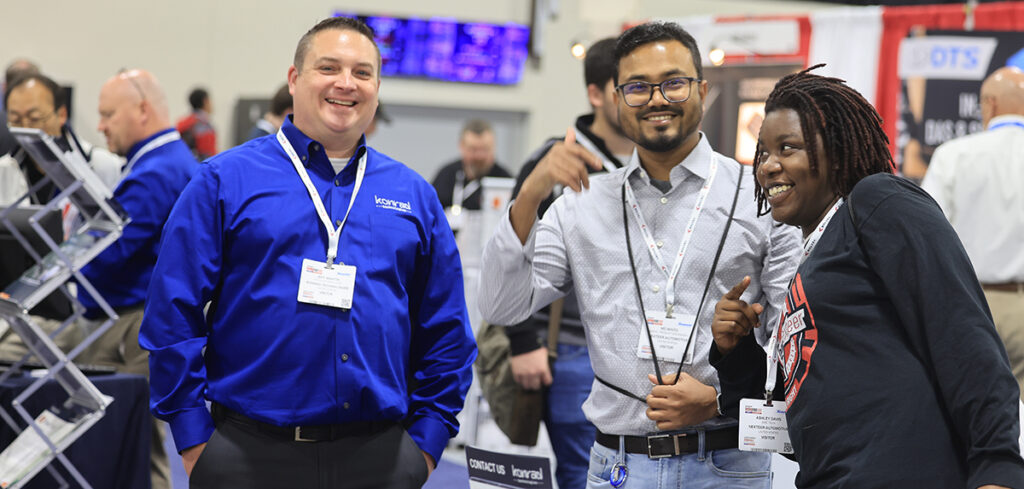Automotive Testing Expo kicked off yesterday (Tuesday) at the Suburban Collection Showplace in Novi, Michigan, marking the return to a full-capacity, full-size show with person-to-person discussions and physical demonstrations. The show runs until Thursday, October 27 and is completely free to attend.
With 280+ exhibitors displaying their very latest products and services, visitors are seeing the most up-to-date technologies in ADAS and autonomous vehicle testing, NVH measurement tools, test rigs, simulation packages, durability testing technologies, crash testing, dynamometers, emission measurement systems and dynamic assessment tools, as well as countless service providers such as proving grounds and test facilities.
As well as product launches and innovations on the exhibition floor, visitors can hear from more than 40 speakers on the Technology Presentation Stage.
The first day saw new launches and cutting-edge technology across the show, including the latest from DTS, Eye Applied Optix, Michelin Laurens Proving Grounds and Atesteo. Here are a few highlights…
Innovative in-dummy DAS technology and new accessories to support tests with multiple ATDs
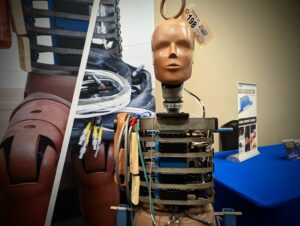 DTS has its roots in automotive safety testing. At Automotive Testing Expo this year, the company is highlighting its innovative in-dummy data acquisition system (DAS) technology and new accessories to support high channel count tests with multiple ATDs.
DTS has its roots in automotive safety testing. At Automotive Testing Expo this year, the company is highlighting its innovative in-dummy data acquisition system (DAS) technology and new accessories to support high channel count tests with multiple ATDs.
According to Shelly Horvath, marketing manager at DTS, embedding the DAS in the ATD decreases in-dummy cabling by up to 75%, significantly reducing test setup time and eliminating the mass and noise of long sensor cables. She explained, “We like to say that DTS DAS makes dummies ‘smarter’. In-dummy DAS makes everything much more efficient, plus it improves data quality and reliability. There is even a built-in tri-axial tilt sensor specifically for dummy positioning.”
Crash test dummies allow testing to take physical measurements of how a human body would respond during a collision. The data collected helps engineers to evaluate and design safer vehicles and save lives around the world.
This year, DTS is again hosting the Innovation Room which features the latest technology plus two special events:
- DTS Users Meeting, which was held the morning of Day 1 (Tuesday)
- DTS Chicken & Waffles Brunch. Wednesday, October 26, 10:30am-12:30pm.
Please RSVP at https://dtsweb.com/innovation-room-rsvp/
DTS attends Automotive Testing Expo every year to meet up with customers from around the world and to connect with new people in the automotive industry and beyond. “It’s the only forum truly dedicated to automotive safety testing,” Horvath enthused.
Booth 15008
Super UV weathering chamber for polymers, paints and coatings
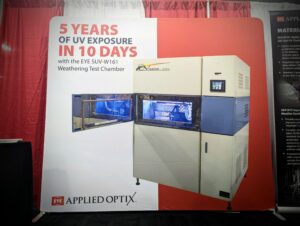 Day 1 of Automotive Testing Expo saw Eye Applied Optix showcase its Super UV weathering chamber. This uses a metal halide light source instead of the traditionally used fluorescent UV or xenon light sources.
Day 1 of Automotive Testing Expo saw Eye Applied Optix showcase its Super UV weathering chamber. This uses a metal halide light source instead of the traditionally used fluorescent UV or xenon light sources.
According to Doug Vermillion, director at Eye Applied Optix, the weathering chamber is a game-changer because it significantly reduces screening test time for weather testing polymers, paints and coatings.
“The Super UV chamber can produce screening test results in a fraction of the time required by traditional weathering chambers,” Vermillion explained. “This means significantly reduced time-to-market for new products, faster analysis of product performance, better understanding of potential warranty cost, technical feasibility of ideas, and many other product development criteria that have a major impact on a company’s bottom line.”
He continued, “ASTM G155 Cycle 1 is a commonly run xenon test. A customer may run 2,500 cycles of this test, which takes 5,000 hours or 208 days. The Super UV chamber can provide an equivalent UV dosage in a fraction of the time, taking only 194 hours or eight days.”
Eye Applied Optix manufactures a wide range of lighting that is used for automotive testing applications including crash test lighting, emissions lighting and thermal test lighting systems. Its Super UV is a weathering test chamber, a tool widely used in automotive testing.
Mark Alessandro, global R&D durability manager at Avery Dennison, commented, “The Super UV [weathering chamber] provides highly accelerated data compared to xenon and fluorescent tools. We’re able to rapidly screen formulations, increase test throughput and correlate to outdoor and traditional test methods.”
Booth 8048
Sustainability initiatives and infrastructure upgrades at Michelin Laurens Proving Grounds
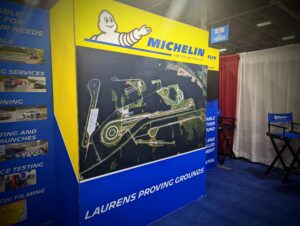 Michelin Laurens Proving Grounds is in Novi to reveal that it has completed several infrastructure and sustainability initiatives that will allow customers to test a wide range of vehicles at any time of the year.
Michelin Laurens Proving Grounds is in Novi to reveal that it has completed several infrastructure and sustainability initiatives that will allow customers to test a wide range of vehicles at any time of the year.
Recently completed projects include the installation of multiple Level 3 DC fast chargers, an upgraded fire system allowing indoor electric vehicle storage for optimal confidentiality and a completely renovated main pumphouse that has achieved a 75% water usage reduction. The facility has also repainted lines around the majority of the main tracks, improving conditions for autonomous testing.
A wide range of services is offered, including turnkey testing, track rentals, driver training and corporate and team events that extend to beyond the automotive sector. Tracks available for use range from dry tracks to wet tracks and include offroad surfaces. The facility’s diverse capabilities ensure a solution for almost any customer, with staff on hand to offer flexible and prompt support of any needs that may arise throughout the entire visit experience.
“Michelin Laurens Proving Grounds is proud to share that its recent main water pumphouse renovation has culminated in a water usage saving of 75%,” revealed Michelle Philipps, coordinator of engineering and services, live at the expo. “This pumphouse provides water to our wet skid pad and braking areas. With this improvement project, along with the additions of multiple Level 3 DC fast chargers and LED lighting around the facility, our customers should have peace of mind that testing at our facility can be considered a ‘green’ way to complete their testing projects.”
According to Michelle, Automotive Testing Expo offers an ideal avenue for proving grounds to communicate their improvements as it touches the vast majority of OEs and OEMs that comprise the majority of customers.
Booth 9038
New Atesteo testing site in Michigan and Testing Cockpit live demo
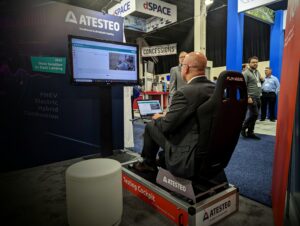 Atesteo has revealed that it is building its new Atesteo North America headquarters in East Lansing, Michigan, to accelerate electric and hybrid drive development in the USA. The company is the leading drivetrain testing specialist for early testing of new drivetrains on test benches.
Atesteo has revealed that it is building its new Atesteo North America headquarters in East Lansing, Michigan, to accelerate electric and hybrid drive development in the USA. The company is the leading drivetrain testing specialist for early testing of new drivetrains on test benches.
The new testing site will begin operations in 2023 with 10 adaptable high-end drivetrain test benches for testing battery, fuel cell, hybrid and ICE drives. Atesteo North America will offer complete drivetrain testing in East Lansing, conducting tests on endurance, service life, efficiency, NVH behavior and environmental interactions of the drivetrain and individual components. In addition, Atesteo will offer a DAkkS-accredited calibration laboratory for torque.
Tim Willers, CEO at Atesteo, explained, “In the heart of the American automotive industry, our new site closes a gap in the worldwide coverage of our services where drivetrain development occurs. We shape the future of mobility together with the automotive industry in the USA.”
In addition to promoting its new testing site, Atesteo North America is also giving a live demo of its Testing Cockpit, which enables customers to participate in testing projects any time, and the latest testing, evaluation and measurement technology developments.
Tim Willers and President Roy M Schulde will be at the show daily to give manufacturers the opportunity to speak personally to the company.
Booth 3011
Technology Presentation Stage: How BMW uses AI to accelerate crash tests
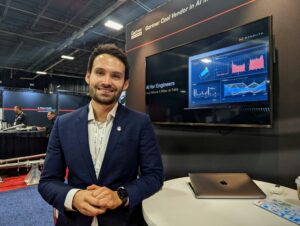 Day 1 of Automotive Testing Expo saw Dr Richard Ahlfeld, CEO at Monolith, give a presentation on How BMW uses AI to accelerate crash tests on the Technology Presentation Stage.
Day 1 of Automotive Testing Expo saw Dr Richard Ahlfeld, CEO at Monolith, give a presentation on How BMW uses AI to accelerate crash tests on the Technology Presentation Stage.
Ahlfeld revealed how, using Monolith’s no-code AI crash testing software, BMW Group engineers built self-learning models using existing crash data and were able to accurately predict the force on the tibia for a range of different crash types without doing physical crashes. This game-changing approach will enable engineers to reduce physical tests and cut product development time by 50%.
Ahlfeld explained that the Monolith AI crash testing platform was developed with a laser focus on user experience by automotive experts and data scientists to ensure seamless integration with existing engineering processes.
“By adopting data-driven methods and self-learning models, engineers can optimize crash performance earlier in the design process and reduce dependence on time-intensive, costly testing whilst making historical data infinitely more valuable,” he said.
“The accuracy of the self-learning models will continue to improve as more data becomes available and the platform is further embedded into BMW’s engineering workflow and functions across R&D that generate vast amounts of data from crash testing to aerodynamics, motorsports and advanced driver-assist systems [ADAS].”
Ahlfeld continued, “We’re in Detroit to share the results of our work with BMW and share ideas on the future of engineering – namely the role of AI. We’re looking forward to expanding our network and further understanding the needs of engineers. We had a great experience at Automotive Testing Expo Stuttgart so look forward to more of the same.”
Monolith is also sharing its swarming technology on the exhibition floor.
Booth 15036
Technology Presentation Stage: Autonomous Solutions demonstrates robotic choreographed testing for ADAS/AVs
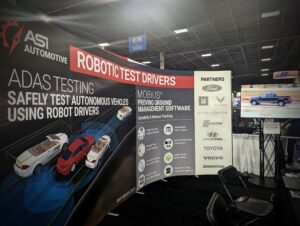 Jed Judd, automotive product manager at Autonomous Solutions Inc (ASI), talked about Robotic choreographed testing for ADAS/AVs on the Technology Presentation Stage.
Jed Judd, automotive product manager at Autonomous Solutions Inc (ASI), talked about Robotic choreographed testing for ADAS/AVs on the Technology Presentation Stage.
Judd revealed how, alongside a world-leading OEM, ASI has developed autonomous technology capable of choreographed testing of ADAS/AV systems. The company calls this technology Swarming.
Driven by robotic systems, autonomous vehicles are capable of tighter, more accurate positioning than manned vehicles can safely perform. Swarming uses vehicle-to-vehicle and vehicle-to-server communications with advanced control algorithms, ensuring autonomous vehicles will be posed at predefined positions and velocities at given times. The technology fully exercises the responses of the entire ADAS/AV systems required for autonomous driving. When triggered, Mobius – ASI’s command and control software — releases control to the ADAS/AV system while continually monitoring safety, ready to regain control instantly if conditions are not nominal.
Jaren Devey, ASI’s automotive development manager, said, “We realize that testing high-speed collision anticipation and avoidance is simply too dangerous for human drivers, yet the need for this is now. Our solution is to use robot drivers during these dangerous testing phases, so that OEMs can test their vehicles to the extreme limits of their engineering while ensuring the safety of everyone involved.”
ASI revealed that this robotic system is already giving value in durability, misuse, impact, noise and vibration, ADA/AV systems, and more use cases.
According to Judd, ASI has attended Automotive Testing Expo North America for several years and has found it to be a great place to showcase the advantages of using robotic test drivers on proving grounds for OEMs and Tier suppliers. The company looks forward to meeting more potential customers and exploring how its solutions can help solve their use cases.
The company is also showcasing its technologies on the exhibition floor. Visit the ASI booth to find out more.
Booth 6024
S Bleyer showcases wheel hub fixations for heavier vehicles and wind tunnel fan
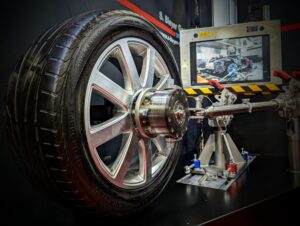 One of the main things German company S Bleyer is in Novi to display is its wheel hub fixations, which are increasingly in demand by North American customers.
One of the main things German company S Bleyer is in Novi to display is its wheel hub fixations, which are increasingly in demand by North American customers.
Adding to its well-known vehicle fixations for LDVs (<3.5t gross weight) Bleyer has now also developed hook and wheel hub fixation systems for MDVs (<7t gross weight) and a wheel hub fixation system for heavy-duty trucks (<11.5t weight per axle). While hook systems limit the application – usually to less dynamic tests such as exhaust test and similar – the wheel hub fixations enable unlimited testing of the restrained vehicles within the limits of the defined weights. Thus, the wheel hub fixation systems enable full acceleration, full braking, unlimited speeds and whatever the test facilities like to do on dynos.
Bleyer is also displaying its revised fan motor design for wind tunnels, developed to ease the replacement of fan motor bearings when they wear out every 10 years or so. “Conventionally, the fans have to be removed from the wind tunnel (by opening the roof and taking them out) for revision,” explained Jens Bormann, managing director at S Bleyer. “Our method allows an in-situ revision inside the tunnel.” The company recently carried out such a revision at BMW, successfully completing the job within four weeks.
“The in-situ fan motor revision at BMW Munich not only saved significant time and money, but also made it possible to revise only the motor in this case,” Bormann continued. “The conventional option to remove the fan from the building for revision was no longer possible due to local infrastructural restrictions, so without our in-situ method, the revision would not have been possible at all.”
Bormann says the company is mainly using the expo to focus on vehicle fixations, exhaust adaptations and x-y-z systems for driving aids, measuring boxes and mixing-T’s. “We also do all kinds of custom-designed solutions in test cells and the fan motor revision was one of our highlights last year. We chose Automotive Testing Expo Novi to exhibit because we are looking more and more into the North American market and like to meet customers face-to-face.”
Booth 15044
Dytran displays its new, simplified miniature multichannel datalogger
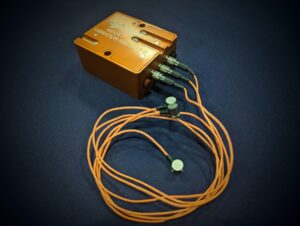 Dytran is in Novi to show its new 4600A1 VibraCorder. When combined with the company’s wide range of accelerometers, the solution enables users to capture vibration data from a variety of automotive components, including circuit boards, suspension components, luxury seating and exhaust manifolds.
Dytran is in Novi to show its new 4600A1 VibraCorder. When combined with the company’s wide range of accelerometers, the solution enables users to capture vibration data from a variety of automotive components, including circuit boards, suspension components, luxury seating and exhaust manifolds.
According to Brian Johnson, product manager at Dytran, “Vibration is a critical aspect of evaluating the longevity of a design. Fatigue loading of components can cause premature failure and lead to costly warranty issues over the life of a vehicle. Vibration measurements are a critical aspect in validating loading criteria to ensure the component and system design can endure the intended lifecycle.”
The 4600A1 enables users to capture data simultaneously from three channels at up to 25,000 samples per second, for 10 hours. The integrated eight-pole elliptical anti-aliasing filter ensures the sampled data is free from the effects of aliasing. Each channel provides IEPE signal conditioning with AC coupling and 2mA constant current excitation with a 19V DC compliance voltage, for use with a wide range of IEPE sensors – single or triaxial accelerometers, dynamic force and pressure sensors, and impulse hammers.
“This cost-effective and portable data recorder allows users to expand their channel count as their measurement needs change or expand with optical and wire synchronization options between multiple VibraCorders,” Johnson continued. “This enables users to monitor additional components on their vehicle or conduct large-scale testing with distributed acquisition.”
Units are supplied with an easy-to-navigate software package that enables the configuration of the recording parameters, stored on the included micro SD card. The software also allows the user to view the recorded data, process data with a variety of post-processing tools (filtering, integration, FFT, etc) and export data into a variety of industry-standard formats to allow further analysis in the software of choice.
“A benefit of having multiple synchronized data channels is that engineers can use accelerometers to conduct modal analysis or capture data from multiple locations where the phase relationship between those components can provide critical information about the dynamic characteristics of the structure,” said Johnson.
According to Denis Varak, Dytran’s technical director, the 4600A1 provides users with a compact, battery-powered, cost-effective data recorder with excellent (IP64) environmental protection. It is small enough to be mounted in locations where other loggers may not fit and the environmental protection enables the logger to be mounted near critical components on the suspension or chassis without fear of damage from water spray or dust. The internal battery enables rapid deployment without the worry of routing power cables or connecting to the vehicle’s power.
“When developing the 4600A1 VibraCorder we focused on creating a tool that would provide excellent value to end users,” explained Varak. “There are many excellent data acquisition systems on the market that provide a ton of functionality for power users, but we wanted to create a simplified tool that could deliver trusted performance, rugged construction and portability at an affordable price – a tool that should be in every test engineer’s field bag. We believe we hit the mark with the 4600A1.”
“Automotive Testing Expo North America brings together leading industry professionals in the field of automotive testing, development and validation,” added Johnson. “Dytran is a regular exhibitor here, and we value the feedback and discussions we have with attendees and exhibitors alike. These discussions help shape the future development of new and innovative products like the 4600A1 VibraCorder to empower automotive testing professionals with their future testing needs.”
Booth 6056


